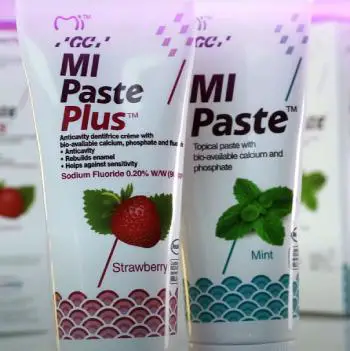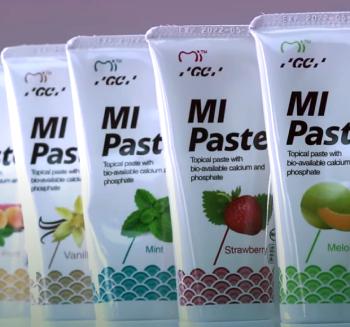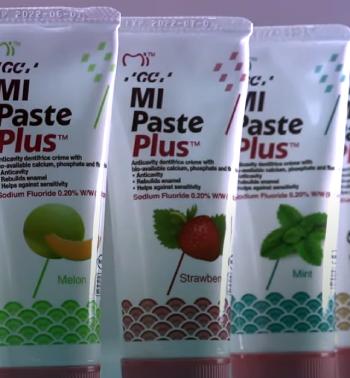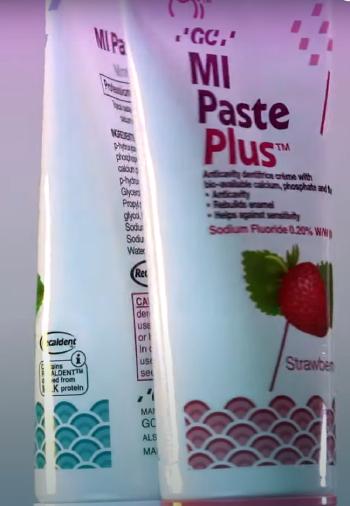I’ve always been a bit of a dental care enthusiast, constantly on the lookout for products that can keep my smile bright and my teeth strong. When I stumbled across MI Paste and MI Paste Plus, I was intrigued by their promises to remineralize enamel and soothe sensitivity.
But as I dug into these two products, I realized the choice between them isn’t as straightforward as it seems. My goal here is to break down the differences, weigh the pros and cons, and help you decide which one might be the best fit for your dental needs.
Let’s get started with a side-by-side comparison.
A Brief Comparison Table
| Feature | MI Paste | MI Paste Plus |
| Main Ingredient | Recaldent (CPP-ACP) | Recaldent (CPP-ACP) + 900 ppm Fluoride |
| Fluoride Content | None | 0.2% Sodium Fluoride (900 ppm) |
| Primary Use | Remineralization, sensitivity relief | Enhanced remineralization, cavity prevention |
| Target Audience | General use, including kids under 6 and pregnant women | Adults and kids over 6 with higher cavity risk |
| Flavors | Mint, Strawberry, Melon, Vanilla, Tutti-Frutti | Mint, Strawberry, Melon, Vanilla, Tutti-Frutti |
| Application | Topical cream, applied post-brushing | Topical cream, applied post-brushing |
| Allergy Concerns | Not for milk protein allergy sufferers | Not for milk protein allergy sufferers |
| Availability | Over-the-counter, dentist offices | Over-the-counter, dentist offices |
| Price (Approx.) | $15–$25 per 40g tube | $18–$30 per 40g tube |
What Are MI Paste and MI Paste Plus?

As someone who’s tried countless dental products, I was curious about what makes MI Paste and MI Paste Plus stand out.
Both are topical tooth creams from GC America, designed to deliver essential minerals to your teeth.
The star ingredient in both is Recaldent, a milk-derived protein known as Casein Phosphopeptide-Amorphous Calcium Phosphate (CPP-ACP).
This mouthful of a name boils down to a simple function: it binds calcium and phosphate to your teeth, helping to rebuild enamel and reduce sensitivity.
I first learned about these products from my dentist, who recommended them after a particularly aggressive teeth-whitening session left my teeth feeling sensitive.
What caught my attention was how these creams mimic the natural protective role of saliva, which supplies minerals to strengthen enamel. But where MI Paste and MI Paste Plus part ways is in their fluoride content—and that’s where the real decision-making begins.
The Core Difference: Fluoride or No Fluoride?
Here’s the deal: MI Paste is fluoride-free, while MI Paste Plus packs 900 ppm of sodium fluoride. This distinction shapes everything about how these products work and who they’re best for.
I’ll admit, I was initially skeptical about fluoride. Like many, I’d heard mixed opinions about it, but after researching, I found that fluoride, in the right doses, is a proven cavity fighter. MI Paste Plus combines the remineralizing power of Recaldent with fluoride’s ability to strengthen enamel, making it a heavier hitter for those prone to decay.
On the other hand, MI Paste’s lack of fluoride makes it a gentler option, especially for young kids under six or pregnant women who might want to avoid fluoride.
When I was expecting my daughter, I was extra cautious about what I put in my body, so I appreciated having a fluoride-free option like MI Paste. It’s also a great choice for anyone with dry mouth or mild sensitivity who wants a non-invasive way to protect their teeth.
How Do MI Paste And MI Paste Plus Work?

Let’s talk about the science behind these creams, because understanding how they function helped me appreciate their value.
Both MI Paste and MI Paste Plus use Recaldent to deliver calcium and phosphate directly to your tooth surfaces.
These minerals are like building blocks for enamel, helping to repair areas weakened by acid from food, drinks, or bacteria.
I think of it like patching up tiny cracks in a wall before they turn into bigger problems.
When you apply MI Paste, it sticks to your teeth, plaque, and even soft tissues in your mouth, creating a mineral-rich environment. This process, called remineralization, strengthens enamel and can even reduce the appearance of white spot lesions—those chalky patches that sometimes show up after braces.
MI Paste Plus takes it a step further by adding fluoride, which forms a stronger, more acid-resistant layer of enamel called fluorapatite.
I tried MI Paste after a deep cleaning that left my teeth a bit tender, and I was impressed by how quickly it soothed the sensitivity.
It’s not a toothpaste, though—don’t make the mistake I did and try to brush with it! You apply it after brushing, either with a finger, cotton swab, or a custom dental tray, and let it sit for three to five minutes. It’s simple, but it feels like giving your teeth a little spa treatment.
Pros of MI Paste
Let’s break down why MI Paste might be the right choice for you. Here are the advantages that stood out to me:
- Fluoride-Free: Perfect for kids under six, pregnant women, or anyone avoiding fluoride due to personal preference or medical advice. I found this reassuring when I was pregnant and wanted to minimize my fluoride intake.
- Gentle on Sensitive Teeth: It’s fantastic for soothing sensitivity after whitening or cleanings. After using it for a week post-whitening, I noticed my teeth felt less “zingy” when I sipped cold water.
- Safe for All Ages: Since it’s fluoride-free, it’s suitable for the whole family, provided no one has a milk protein allergy.
- Versatile Use: It’s great for dry mouth, white spot lesions, and general enamel strengthening. I’ve used it during periods of stress when my mouth felt drier than usual, and it helped keep my teeth protected.
- Easy Application: Smearing a pea-sized amount on your teeth is quick and hassle-free. I keep a tube by my sink for nightly use.
Cons of MI Paste
No product is perfect, and MI Paste has some drawbacks I’ve encountered:
- No Fluoride Protection: Without fluoride, it’s less effective at preventing cavities compared to MI Paste Plus. If you’re at high risk for decay, like I was during my teenage years with a soda habit, this might not be enough.
- Allergy Concerns: It’s derived from milk protein, so it’s a no-go if you’re allergic to casein or lactose intolerant. I have a friend who had to skip it because of this.
- Cost: At $15–$25 per 40g tube, it’s pricier than regular toothpaste. I winced a bit at the price tag at first, but the benefits made it worth it for me.
- Not a Toothpaste Replacement: You still need to brush with fluoride toothpaste first, which adds an extra step to your routine. I found this mildly annoying on busy mornings.
Pros of MI Paste Plus
MI Paste Plus brings some extra firepower to the table, and here’s why I think it’s a strong contender:

- Fluoride Boost: The 900 ppm fluoride makes it a powerhouse for cavity prevention. When I was dealing with a cavity-prone phase, my dentist suggested MI Paste Plus, and I noticed fewer issues at my checkups.
- Enhanced Remineralization: The combo of Recaldent and fluoride creates a stronger enamel layer. I could feel the difference in how smooth my teeth felt after a couple of weeks.
- Great for High-Risk Patients: If you have braces, dry mouth, or a history of cavities, this is tailored for you. My cousin, who wears braces, swears by it for keeping white spots at bay.
- Same Easy Application: Like MI Paste, it’s simple to apply with a finger or tray. I love the mint flavor—it feels refreshing without being overpowering.
- Versatile Flavors: With five flavors (mint, strawberry, melon, vanilla, tutti-frutti), there’s something for everyone. I’m partial to strawberry—it’s like a treat for my teeth.
Cons of MI Paste Plus
Even with its strengths, MI Paste Plus has some limitations I’ve noticed:
- Not for Everyone: The fluoride content makes it unsuitable for kids under six or those advised to avoid fluoride. I had to switch to regular MI Paste when my daughter was younger and wanted to “share” my dental routine.
- Allergy Restrictions: Like MI Paste, it’s off-limits for those with milk protein allergies. This is a dealbreaker for some of my friends.
- Slightly Higher Cost: At $18–$30 per tube, it’s a bit more expensive than MI Paste. I budget for it, but it’s something to consider.
- Potential Fluoride Overload: If you’re already using high-fluoride toothpaste or treatments, you might need to check with your dentist to avoid overdoing it. I was cautious about this when combining it with my prescription toothpaste.
Who Should Use MI Paste?
After using MI Paste for a few months, I found it’s best for people who want a gentle, fluoride-free way to strengthen their teeth. It’s ideal if you’re:
- A parent looking for a safe option for young kids.
- Pregnant and avoiding fluoride.
- Dealing with mild sensitivity or dry mouth from medications or lifestyle factors.
- Looking to reduce white spot lesions without invasive treatments.
I recommended it to my sister, who struggles with dry mouth from allergy meds, and she noticed her teeth felt less sensitive after a couple of weeks. It’s a solid choice if you want a low-risk, non-fluoride product that still packs a remineralizing punch.
Who Should Use MI Paste Plus?
MI Paste Plus, on the other hand, is my go-to when I’m worried about cavities or need extra protection. It’s perfect for:
- Adults or kids over six with a higher risk of tooth decay.
- People with braces or orthodontic appliances prone to white spot lesions.
- Those with chronic dry mouth from medical conditions or treatments like chemotherapy.
- Anyone looking for the added cavity-fighting power of fluoride.
When I had braces in my 20s, MI Paste Plus was a lifesaver for preventing those pesky white spots around my brackets. If your dentist has flagged you as cavity-prone, this is likely the better pick.
My Personal Experience With MI Paste And MI Paste Plus

I’ve used both MI Paste and MI Paste Plus at different points in my life, and each has its place.
During pregnancy, I stuck with MI Paste because I wanted to avoid fluoride. It was easy to apply, and I liked how it left my teeth feeling smooth and less sensitive.
After my daughter was born, I switched to MI Paste Plus because my dentist warned me about early signs of decay.
The fluoride boost gave me peace of mind, and I noticed my teeth felt stronger at my next cleaning.
One thing I love about both is the variety of flavors.
I’m not usually a fan of dental products tasting like dessert, but the strawberry and melon options make the experience more pleasant.
My only gripe is the extra step in my routine—brushing, flossing, then applying the paste can feel like a chore when I’m tired. But the results? Worth it.
Comparing Effectiveness: What The Research Says
I’m a bit of a research nerd, so I looked into studies comparing MI Paste and MI Paste Plus. The results are mixed, which is frustrating but not surprising.
A 2014 study found no significant difference between MI Paste Plus, fluoride varnish, and standard oral hygiene for improving white spot lesions over eight weeks. That said, a 2011 study showed MI Paste Plus reduced lesion areas more than a control group, suggesting it has an edge for remineralization.
In my experience, MI Paste Plus seems to work faster for sensitivity relief, likely due to the fluoride. But MI Paste holds its own for general enamel strengthening, especially if fluoride isn’t your thing. The key is consistency—using either product daily makes a bigger difference than sporadic use.
Application Tips And Tricks
Applying MI Paste or MI Paste Plus is straightforward, but I’ve picked up a few tips to make it more effective:
- Brush First: Always brush with fluoride toothpaste (if using MI Paste) or a regular toothpaste before applying. This preps your teeth by removing plaque.
- Use a Pea-Sized Amount: A little goes a long way. I dab a small amount on my finger and rub it across my teeth.
- Wait It Out: Let the paste sit for three to five minutes. I use this time to tidy my bathroom or scroll through my phone.
- Don’t Rinse: Spit out the excess but avoid rinsing for at least 30 minutes to let the minerals sink in. I found this hard at first but got used to it.
- Try a Tray: For deeper treatment, ask your dentist for a custom tray. I used one during my braces days, and it ensured even coverage.
Cost And Accessibility
Both products are pricier than your average toothpaste, which was a shock when I first bought them. MI Paste runs about $15–$25 for a 40g tube, while MI Paste Plus is slightly higher at $18–$30.
I’ve found them at dental offices, online retailers like Amazon, and sometimes at pharmacies. If you’re budget-conscious like me, shop around for deals or ask your dentist for samples to try before committing.
Alternatives To Consider
While I’m a fan of MI Paste and MI Paste Plus, I’ve also explored alternatives. BioMin F, for example, uses bioglass technology to deliver calcium, phosphate, and fluoride without milk proteins, making it a good option for those with allergies. It’s also a bit cheaper, around $8–$12 per tube.
Prevident 5000, a prescription high-fluoride toothpaste, is another option for cavity-prone folks, but it lacks the Recaldent component. I tried BioMin F when I was curious about dairy-free options, and it worked well, though I missed the creamy texture of MI Paste.
Making Your Choice
Choosing between MI Paste and MI Paste Plus comes down to your dental needs and preferences. If you’re sensitive to fluoride or need a product for young kids, MI Paste is a safe bet. If cavities are a concern or you’re dealing with braces, MI Paste Plus offers that extra layer of protection.
I always check with my dentist before switching products, especially if I’m combining them with other treatments. Your dentist can assess your risk factors and guide you to the best choice.
Frequently Asked Questions (FAQ)
It depends on your needs. MI Paste is fluoride-free and great for kids under six, pregnant women, or those with mild sensitivity. MI Paste Plus, with 900 ppm fluoride, is better for cavity-prone adults or kids over six. Ask your dentist for personalized advice.
Yes, MI Paste Plus helps remineralize enamel by delivering calcium, phosphate, and fluoride, which strengthen and repair weakened areas. Consistent use can reduce white spot lesions and improve enamel resilience.
The MI Paste family includes MI Paste (fluoride-free), MI Paste Plus (with 900 ppm fluoride), and MI Paste One (a two-in-one toothpaste with Recaldent and fluoride). All come in flavors like mint, strawberry, melon, vanilla, and tutti-frutti.
No, it’s not recommended to leave MI Paste Plus on overnight. Apply it for three to five minutes, then spit out the excess. Avoid rinsing for 30 minutes to maximize benefits, but don’t sleep with it on.
Wrapping Up
Navigating the world of dental care can feel overwhelming, but understanding the differences between MI Paste and MI Paste Plus makes the choice clearer. I’ve found both products to be game-changers for keeping my teeth strong and sensitivity at bay, but your needs will dictate which one suits you best.
If you’re after a gentle, fluoride-free option, MI Paste is your friend. If cavities or braces are a concern, MI Paste Plus offers that extra punch. Talk to your dentist, try a tube, and see what works for you. Your smile deserves it.
